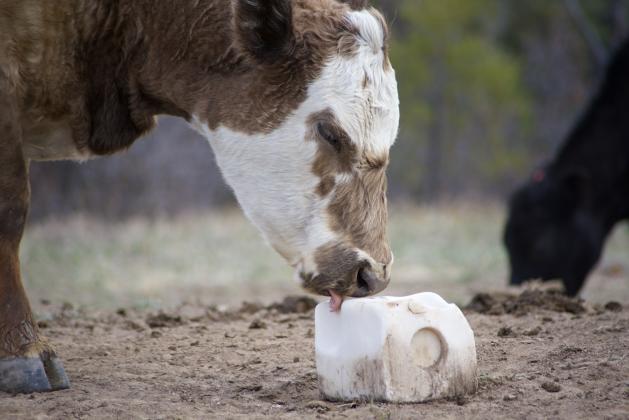Rachael Brooke - Phillips-Rooks District Extension Agent, Agriculture and Natural Resources
When thinking about meeting the nutritional needs of beef cow-calf herds, the first focus should be on the ability of the base forage to meet the energy and protein needs of the various groups of cattle on the ranch that differ by age and lactation status. Another aspect of nutrition that must also be considered is the mineral content of the diet. The minerals available from grazed and harvested forages and feed depend greatly on the soil on which it is grown as well as the type of plant being consumed. Because of the importance that soil plays in the availability of many minerals, supplementation needs can vary. In addition, mineral needs (particularly calcium and phosphorus) will increase somewhat in late gestation and to a greater extent during lactation compared to non-lactating cattle (heifers, dry cows, bulls).
Several minerals are necessary in beef cattle diets to maintain optimum health, reproduction, and growth. The major minerals that most commonly need to be supplemented in beef cattle diets are sodium (salt), calcium, and phosphorus, while magnesium and potassium are major minerals that require supplementation under certain circumstances. The six trace minerals that may be deficient in forage-based diets are copper, cobalt, iodine, selenium, zinc and manganese.
The mineral needed in the greatest amount in beef diets is salt (sodium chloride). Because salt is deficient in most natural feeds, it should be supplemented in all situations. The level of salt needed can vary depending on the diet, type of cattle, and environmental conditions, but a general rule is to supply 1 to 2 oz. per day.
Calcium and phosphorus are often considered together. Calcium content of grass decreases somewhat as forage matures and becomes dormant but often maintains levels that supply dietary needs throughout the year. Phosphorus, however, is leached out of dormant forage, so that by mid-winter levels are much lower than while forages are growing. Grains and many by-product feeds used to supplement cows on dormant forage such as wheat midds, soybean products, distillers’ grains, and corn gluten feed have high phosphorus content that will likely provide sufficient levels in the diet.
Deficiency of magnesium is identified as a condition known as grass tetany. Observed most frequently in the early spring, grass tetany results from the consumption of lush forage, which has low levels of magnesium and sodium and has an excess of potassium. In addition to plant factors, grass tetany is associated with late pregnancy and early lactation due to the movement of calcium, phosphorus, and magnesium out of blood circulation and into the udder for milk production. During periods when grass tetany is a danger, a mineral mix with at least 18% magnesium needs to be offered.
Minerals needed in small amounts are called trace minerals, and in most situations, requirements are met with grazed forages or supplemental feedstuffs. However, deficiencies or imbalances of trace minerals can occur when cattle grazing on some soil types consume plants that are either deficient in some important trace minerals or have excessive amounts of minerals that will tie-up or prevent the proper utilization of other minerals.
Commercial mineral supplements are widely available and will meet the needs of most classes of cattle. The amount of each mineral provided by commercial products must be printed on the label. In some situations (due to concentrate feeds used and soil type), no commercial supplement is available to perfectly meet a herd’s mineral needs. In these situations, custom mixes can be created. In this circumstance, the supplier of the supplement will work with the producer to provide the proper level of minerals based on analysis of the animal’s diet.
Salt and other minerals can be delivered to cattle in several forms. If possible, minerals can be mixed into hand-fed protein or energy supplements so that all cattle are more likely to receive their allotted amount. However, if no supplement is being fed or if it is difficult or impossible to add minerals to the supplement, salt/mineral can be offered free choice in a loose granular form or as a block or tub (or other solid or semi-solid form). All free-choice methods of mineral delivery will likely result in some cattle consuming far more and others far less than the desired amount. It has been reported that supplying salt/mineral in a loose form results in the highest intake, but because of loss to wind and weather or because of other convenience factors, a solid or semi-solid form may be more appropriate in some situations. Many commercial protein supplements – whether in a pellet, cake, tub or liquid form, have salt and other minerals added so that additional mineral supplementation is not needed.
Because cows do not have the nutritional wisdom to consume the proper amount of free-choice mineral supplement to meet their dietary requirement or to avoid toxicity, it is important to monitor mineral intake. Determining the amount of mineral consumed over several days is necessary in order to know the herd’s average consumption. If consumption is too low, feed intake enhancers such as dry molasses, wheat midds, cottonseed meal or flavoring may be added. If consumption is too high, salt may be used to limit intake to desired levels.
For more information, please contact the local K-State Research and Extension Office.
K-State Research and Extension is an equal opportunity provider and employer.

